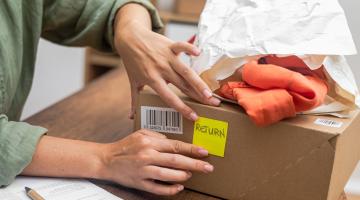
David Guggina, Walmart executive vice president, supply chain operations and Jane Ewing, Walmart senior vice president, sustainability, speak at NRF Supply Chain 360 during NRF 2024: Retail's Big Show.
Browse photos, blog posts, videos and more from NRF 2024: Retail’s Big Show.
Seeking “transparency” in supply chain strategy? Jane Ewing, Walmart senior vice president, sustainability, and David Guggina, Walmart executive vice president, supply chain operations, pulled back the curtain on their own company’s efforts at NRF 2024: Retail’s Big Show.
As part of the NRF Supply Chain 360 Summit at the event, the two spoke about how supply chain sustainability can build more resilient, more effective supply chains; help ensure better availability and better quality of products; mitigate risk; and create opportunities for workers.
A commitment to regeneration
Ewing kicked off with a bit of history, starting with the devastating impact of 2005’s Hurricane Katrina in New Orleans. Walmart trucks lined up to help. “They were there to help the community at its time of need,” she said. “They were on the ground, and they were supporting the community, our customers, our associates, and trying to help them through a really difficult time.”
The CEO then asked how Walmart could be that kind of company every day, Ewing said, using its scale for good. It was also a time for a closer look at the impact of climate change, and what the company needed to do.
“We set some goals back in 2005 to try and become a more sustainable company,” she said. Walmart has been on that journey ever since, reupping its commitment in 2020 by setting out to be a regenerative company. Regeneration is a broad concept beyond just sustainability, she said, incorporating opportunity for people, the impact the company has on communities, ethics, integrity and building trust by doing the right thing.
The key takeaway: “How do we leave things better than we found them? That’s the mindset that we’re trying to build into our business.”
End-to-end network connection
Guggina shared how founder Sam Walton recognized, early on, that in order to deliver on everyday low costs, Walmart needed to control its distribution network. The company stood up the first one, followed by a grocery distribution network and then a fulfilment network. The constant theme, he said, is change.
Customers are changing once again, and Walmart is aiming to “serve them the way that they want to be served in the moment, whether that’s shopping off of our store shelves, having items delivered to their home, in their refrigerator, in their pantry, or picking goods up from their local Supercenter or Neighborhood Market.”
This time, Guggina said, Walmart isn’t standing up another network; it’s bringing the most modern automation into its existing network, using software and robotics to connect the network end to end.
It’s no small task; that supply chain moves more than 100 billion items each year. Key pieces include network design; investments in data, AI and software; and robotics, allowing humans to do what they do best, he said — utilize creativity, empathy and problem-solving skills.
‘Transformation coming to life’
Ewing and Guggina explored specific actions Walmart is taking in terms of sustainability, including sourcing, packaging, partnering with suppliers on goals, products that keep materials in circulation, and more.
As for transportation, there are efforts such as the new Load Planner application, which helps build perishable loads more optimally in the company’s distribution centers. It also helps optimize routing of multi-stop loads; this system alone, Guggina said, has eliminated about 108,000 delivery routes that would otherwise have been taken. That equates to about 33 million miles taken off the road, and almost 100 million pounds of CO2.
“This is our transformation coming to life,” he said. “It’s a win for our team members, our associates, it’s a win for our business, it’s a win for the planet, which is fantastic.”
Check out NRF’s sustainability hub designed to support retailers’ efforts to generate economic value while creating net positive environmental, social and community benefits.
There are also investments in intelligent engines focusing on forecasting, channel flow and inventory placement. There’s rightsizing of corrugate boxes through automation, with boxes being printed at surge rates of 600 boxes per hour. As for delivery, there’s investment in electric and in drones, and an eye toward customer choice. Finally, Ewing added, there are clear commitments on reducing waste in a variety of areas.
Guggina noted how excited they were about robotics and software being deployed throughout the network. “But I am more excited about the impact this is having on reshaping work for our associates,” he said. “We want sticky jobs. We want people staying with us, getting a good job, and it turning into a great career.”


